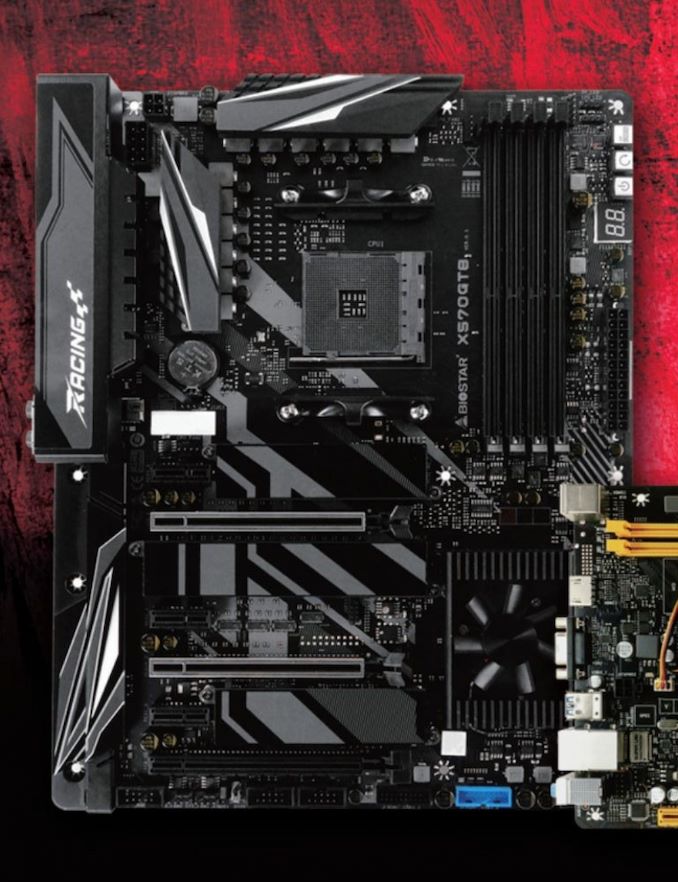The AMD X570 Motherboard Overview: Over 35+ Motherboards Analyzed
by Gavin Bonshor on July 9, 2019 8:00 AM ESTBiostar X570 Racing GT8
As it currently stands, the Biostar X570 Racing GT8 motherboard is the only model from its product stack at the launch of the X570 chipset. Upon speaking to Biostar at Computex, they did go on to say that they will release a mini-ITX model, most likely named the Racing X570GTN; we actually reviewed the previous Biostar X370GTN, and X470GTN AM4 mini-ITX motherboards. The Biostar X570 Racing GT8 has a black and grey PCB, with grey and silver heatsinks and is inspired by motor racing.
The Biostar X570 Racing GT8 ATX motherboard has three full-length PCIe 4.0 slots, with two fed by the CPU supporting x16, x8/x8, and x8/x8/x4 configurations. The bottom full-length slot is fed directly from the X570 chipset and is locked down at x4. There are also three PCIe 4.0 x1 slots available for use. On the black and grey contrasting PCB, with grey heatsinks, Biostar is using a 12-phase power delivery with an 8-pin and 4-pin pairing of 12 V ATX CPU power connectors. In the top-right hand corner of the board is four memory slots with support for up to DDR4-4000, (confirm capacity). On the storage front is three PCIe 4.0 x4 M.2 slots with six SATA ports capable of supporting RAID 0, 1, and 10 arrays.
On the rear panel are five 3.5 mm audio jacks and a S/PDIF optical output controlled by a Realtek ALC1220 8-channel HD audio codec, with the single Ethernet port which is controlled by an Intel I211-AT Gigabit NIC. For users looking to use AMD's Ryzen APUs, the rear panel also has a set of video outputs including a mini-DisplayPort, HDMI and DVI-D output. Also present on the rear panel is four USB 3.1 G1 Type-A and four USB 2.0 ports. (confirm USB). Finishing off the rear panel is a PS/2 combo keyboard and mouse port.
The Biostar X570 Racing GT8 has no MSRP as of yet, but we have reached out to Biostar for this information. Its X570 Racing GT8 looks to amalgamate a sporty racing-inspired design into an attractive ATX gaming model, and with a mixed contrast of black, grey and silver, it's not just the companies flagship X570 model, but as of launch day, it's the only model available from Biostar.











225 Comments
View All Comments
abufrejoval - Tuesday, July 9, 2019 - link
It's amazing how quickly you run out of PCIe lanes, when you don't have switches to multiplex and translate between PCIe revisions and lanes (e.g. PCIe v4 x2 <-> PCIe v2 x8).I find myself using USB 3.x NBase-T NICs and NVMe adapters, simply because they *do* switch.
Bensam123 - Tuesday, July 9, 2019 - link
Maybe a bit more depth on the power delivery page. I have absolutely no idea how to go about parsing what's there. More chokes is better? What denotes a power phase?A5 - Tuesday, July 9, 2019 - link
+1. Some analysis of that information would be helpful.MrSpadge - Tuesday, July 9, 2019 - link
+1bunkle - Wednesday, July 10, 2019 - link
The controller column includes the total number of phases supported split between CPU cores and SoC e.g. (6+1) = 6 CPU phase and 1 SoC phase. More is *usually* better but has diminishing returns regarding tighter and tighter voltage regulation. Some controllers are better than others (can operate at high frequency e.g. 500KHz v 1000KHz, include other features to improve performance) mitigating the need for more phases.Each phase is a buck converter comprised of a low/high side MOSFET (can be integrated in a single package) and choke. Some controllers can support doubling up the PWM signal to driver more MOSFETs. Doublers can also be added as discrete components if not built into the controller.
Current rating of the MOSFET (e.g. Sic639=40A IR3555=60A) indicates the total power deliverable. MOSFETs are not 100% efficient and vary in efficiency. The more current they provide the hotter they get and the less efficient they become, with better MOSFETs producing less heat for a given current. Thus using doubles can improve temperatures and efficiency without the benefits of the tighter voltage tolerance that *real* phases provide.
Hope that’s helpful!
bunkle - Wednesday, July 10, 2019 - link
A lot more detailed explanation: https://en.wikichip.org/wiki/voltage_regulator_mod...bug77 - Tuesday, July 9, 2019 - link
The description for AsRock X570(M) Pro4 says "5 jack + 1 SPDIF". Unfortunately, those boards lack SPDIF and only come with 3 jacks ;)Smell This - Tuesday, July 9, 2019 - link
I'm thinking the *ASRock Thunderbolt AIC* ...https://thunderbolttechnology.net/product/asrock-t...
would cover all your TBT peripheral needs, including optical.
DanNeely - Tuesday, July 9, 2019 - link
Do X570 boards still need an extra chip per USB port to support USB-C reversibility?The additional expense and needed PCB space were cited as among the reasons why earlier generation boards (IIRC both Intel and AMD) almost never had more than 1 C port; but it was never clear to me if that was an inherent implementation penalty for the C port or an artifact of Intel's tech stack being stalled out and AMD outsourcing to ASMedia which built the chipsets on an ancient (55nm) platform.
DigitalFreak - Tuesday, July 9, 2019 - link
Gavin - X370 and X470 only supported PCIe 2.0. The connection between the CPU and chipset was 3.0, but all the ports on the chipset were 2.0.